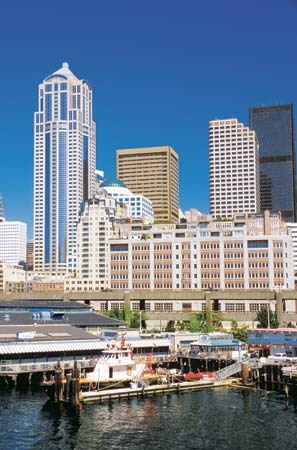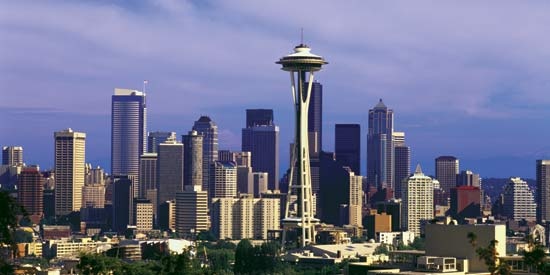Seattle
American Indian chief
also spelled Seathl
(b. c. 1790, Oregon region 【now Seattle, Wash., U.S.】—d. June 7, 1866, Port Madison Reservation, Wash.), chief of the Duwamish, Suquamish, and other Puget Sound tribes who befriended white settlers of the region. Seattle came under the influence of French missionaries, was converted to Roman Catholicism, and instituted morning and evening services among his people—a practice maintained after his death.
In 1855 Seattle signed the Port Elliott treaty, ceding Indian land and establishing a reservation for his people. During the Indian uprising of 1855–58 against whites, he stayed loyal to the settlers. Grateful residents decided to name their growing town after the chief, but Seattle objected on the grounds that his eternal sleep would be interrupted each time a mortal mentioned his name. The conflict was resolved by Seattle's levying a small tax on settlers as advance compensation for the disturbance. In 1890 the city erected a monument over Seattle's grave.
Washington, United States

 chief city of Washington, U.S., on a neck of land between Elliott Bay (Puget Sound) and Lake Washington (a 24-mile 【39-kilometre】 stretch of freshwater), seat (1853) of King county and the largest metropolis of the Pacific Northwest. A port of entry and gateway to the Orient and Alaska, it is surrounded by areas of great natural beauty; to the west, the Olympic Mountains provide protection from heavy winter rains, while the lofty Cascades to the east shield the city from both mid-continental cold and heat. Seattle is the headquarters of the Mount Baker-Snoqualmie National Forest, which extends along the western slopes of the Cascades.
chief city of Washington, U.S., on a neck of land between Elliott Bay (Puget Sound) and Lake Washington (a 24-mile 【39-kilometre】 stretch of freshwater), seat (1853) of King county and the largest metropolis of the Pacific Northwest. A port of entry and gateway to the Orient and Alaska, it is surrounded by areas of great natural beauty; to the west, the Olympic Mountains provide protection from heavy winter rains, while the lofty Cascades to the east shield the city from both mid-continental cold and heat. Seattle is the headquarters of the Mount Baker-Snoqualmie National Forest, which extends along the western slopes of the Cascades.The first white settlement was made at Alki Point in 1851. The town, laid out in 1853 and named for an Indian chief who had befriended the early settlers, grew as a sawmill centre. It successfully withstood an Indian attack in 1856 (with the aid of the U.S. sloop Decatur) and survived anti-Chinese riots in the 1880s and a disastrous fire in 1889.
The town's development was slow until the Great Northern Railway arrived in 1893, making it a major rail terminus. With a fine landlocked harbour, Seattle became the main supply depot for the Yukon and Alaskan gold rushes in the 1890s. Its strategic location, close to the “great circle” route to the Orient, and its position as the southern terminus of the Inside Passage to Alaska, helped develop the harbour into one of the world's great seaports, with more than 50 miles (80 km) of wharves. A grading project was initiated in the early 1900s to remove hills in the downtown area by sluicing methods, using the fill for harbour development.
Between 1905 and 1910, 10 surrounding cities and towns were annexed, and Seattle's population grew to 237,194. The opening of the Panama Canal (1914), completion (1916) of the Lake Washington Ship Canal (linking the outer harbour 【Elliott Bay】 with the inner harbour 【Lake Washington】), and development of the city's Smith Cove piers and Duwamish Waterway heralded a new period of commercial growth. World War II brought a great boom, with shipyards and the aircraft industry playing important roles.
Within Seattle's present diversified economic complex are manufacturing (with heavy emphasis on aerospace industries, machinery, and forest products), food processing, banking, insurance, and transportation. Biomedical, ocean science, and electronics-based industries are important as well. Seattle was the headquarters for the Boeing Company before it relocated to Chicago in 2001 (it still maintains a large presence in the city) and is the site of Fort Lawton (established in 1897) and Sand Point Naval Air Base. It is also the home port for a large fishing fleet and the Puget Sound and Olympic Peninsula ferries.
 Seattle Center (the 74-acre 【30-hectare】 site of the 1962 World's Fair) contains the 607-foot- (185-metre-) high Space Needle, the Opera House, and other public buildings. Parks include Woodland Park and Zoo, Pioneer Square, Volunteer Park (with a memorial to the 1867 Alaska Purchase), and Alki Point. The Seattle Art Museum reflects the city's Oriental and Indian influences. Lake Washington, forming the city's eastern boundary, is a course for motorboat (Gold Cup), crew, and yacht races. Seattle is the seat of the University of Washington (1861), which is housed in the former buildings of the 1909 Alaska-Yukon-Pacific Exposition. The city also has Seattle University (1891), Seattle Pacific University (1891), Cornish College of the Arts (1914), and four community colleges. Inc. town, 1865; city, 1869. Pop. (2000) city, 563,374; Seattle-Tacoma-Bellevue MSA, 3,043,878; (2005 est.) city, 573,911; Seattle-Tacoma-Bellevue MSA, 3,203,314.
Seattle Center (the 74-acre 【30-hectare】 site of the 1962 World's Fair) contains the 607-foot- (185-metre-) high Space Needle, the Opera House, and other public buildings. Parks include Woodland Park and Zoo, Pioneer Square, Volunteer Park (with a memorial to the 1867 Alaska Purchase), and Alki Point. The Seattle Art Museum reflects the city's Oriental and Indian influences. Lake Washington, forming the city's eastern boundary, is a course for motorboat (Gold Cup), crew, and yacht races. Seattle is the seat of the University of Washington (1861), which is housed in the former buildings of the 1909 Alaska-Yukon-Pacific Exposition. The city also has Seattle University (1891), Seattle Pacific University (1891), Cornish College of the Arts (1914), and four community colleges. Inc. town, 1865; city, 1869. Pop. (2000) city, 563,374; Seattle-Tacoma-Bellevue MSA, 3,043,878; (2005 est.) city, 573,911; Seattle-Tacoma-Bellevue MSA, 3,203,314.- Zhang Zhidong
- Zhangzhou
- Zhang Ziping
- Zhang Zuolin
- Zhanjiang
- Zhao
- Zhao Gao
- Zhaohui
- Zhao Mengfu
- Zhaoqing
- Zhao Rukuo
- Zhao Shuli
- Zhao Youqin
- Zhao Ziyang
- Zhdanov, Andrey Aleksandrovich
- Zhdanovshchina
- Zheleznogorsk
- Zhelyabov, Andrey Ivanovich
- zheng
- Zheng Chenggong
- Zhengde
- Zhengding
- Zheng He
- Zheng Qiao
- Zhengtong